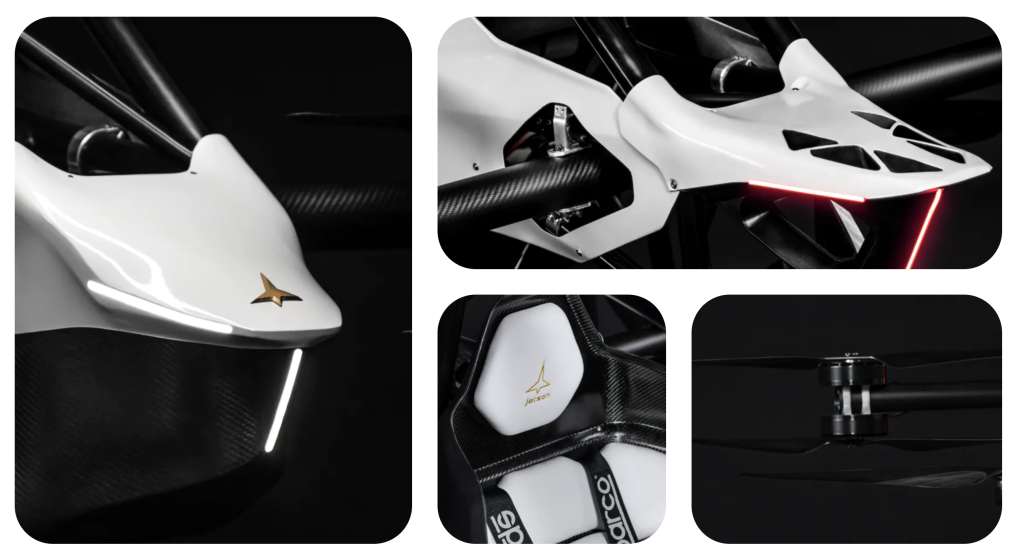The 3D Printing Industry Awards 2022 shortlists are now available for voting. Who will win the 2022 3DPI Awards? Have your say by casting your vote now.
Swedish aerospace start-up Jetson has revealed how 3D printing has helped build the electric vertical take-off and landing aircraft (eVTOL) it launched last year.
Designed to blur the line between driving and flying, the Jetson ONE is essentially a small private aircraft that anyone with ambitions of taking to the skies (and a spare $92,000) can buy and fly themselves. Using a Sinterit Lisa X, the firm has been able to not only iterate upon prototypes, but to produce low volumes of end-parts for the eVTOL, which would otherwise be costly to create via casting or molding.
“We are using the printers for making prototypes, as we are trying different things. It is also nice to model something in CAD software, print it, and physically hold it in your hand and put it on the vehicle,” said Alec Bialek, Head of R&D at Jetson. “When 3D printing is so cheap, so accessible and so quick, it is actually a really great tool to sanity check your own designs.”
Jetson’s mission to ‘democratize’ flight
Based in Stockholm, Jetson is a company on a mission to change the way we travel. More specifically, the firm aims to ‘democratize flight’ via the launch of a personal electric aerial vehicle that “makes the skies available for everyone.”
Since building its first proof-of-concept in 2018, the start-up has gone on to develop a consumer-friendly version: the Jetson ONE. Eventually brought to market in October 2021, the small aircraft features an aluminum and carbon fiber frame as well as eight powerful motors, with enough power to propel passengers at speeds of up to 63 mph.
While marketed as a “Formula One racing car for the sky,” the Jetson ONE is said to be easy to fly, taking just five minutes to learn how to operate. This is thanks to its intelligent flight computer in addition to its intuitive controls, with users’ left hand controlling altitude, and their right controlling direction. The new eVTOL is also said to be cheaper than its rivals, and it doesn’t require a pilot’s license to fly in the US.
Though it’s only capable of flying for 20 minutes at a time, that’s more than enough time for pilots to potentially get themselves into hot water. Recognizing this, Jetson has fitted its new aircraft with a race-car inspired safety cell that protects the pilot. The eVTOL can also fly with seven motors if needed, and features an auto-land function, to ensure that democratized flight doesn’t come at the expense of safety.

Flight-ready eVTOL 3D printing
As you’d expect of a flying vehicle, the Jetson ONE’s design is extremely weight-sensitive, meaning that lightweighting was key to its development. Using 3D printing, Jetson found that it was able to design some of the eVTOL’s parts to feature hollow structures and very narrow lattice patterns, which are lightweight yet strong enough for sustained flight.
Of the technologies out there the firm could’ve picked to develop these parts (as well as a number of prototypes), it chose Selective Laser Sintering (SLS) due to its speed, plus the strength and quality of the support-free structures it produces. As Bialek explains, Jetson initially started out with a Sinterit Lisa Pro before eventually moving onto the faster, larger Lisa X system.
“When we look at the Lisa line of printers, the two major things that we liked were the materials, that are open source, so we are not locked into one brand,” said Bialek. “Another thing was how good the customer service has been. We were quite happy with all the support we received for Lisa Pro. When we were looking for a bigger printer we had a good experience, with no complaints, so it was a very painless upgrade for us.”
Jetson’s engineers now use the Lisa X to 3D print the brackets that hold the motor speed controllers and inverters of its personal aircraft in place. The Jetson ONE’s bezel trim for its instrument cluster, as well as its radar and GPS antenna, are also made using 3D printing, as are the test templates used to assemble the vehicle.
The first Jetson ONEs are set to be delivered between October and December 2023. While Jetson’s 2022 and 2023 production models have already sold out, it is still accepting orders for 2024 deliveries. Customers interested in ordering a Jetson ONE need to make a down payment of $22,000, before paying another $70,000 once it’s ready for delivery.

Additive manufacturing eVTOLs is by no means the norm, but there’s evidence to suggest that some EV and airborne vehicle parts are increasingly being made using 3D printing. In fact, as Materialise’s Q3 2021 financials were released last year, its CEO Fried Vancraen explained how its technologies have already been deployed in the production of the Lift Aircraft electric taxi.
More broadly, the technology continues to find applications within drone manufacturing as well. Earlier this year, for instance, it was revealed that the Royal Air Force (RAF) in Britain is developing an aerial attack unit featuring 3D printed drones that can be fitted with munitions and used to destroy strategic targets.
To stay up to date with the latest 3D printing news, don’t forget to subscribe to the 3D Printing Industry newsletter or follow us on Twitter or liking our page on Facebook.
While you’re here, why not subscribe to our Youtube channel? featuring discussion, debriefs, video shorts and webinar replays.
Are you looking for a job in the additive manufacturing industry? Visit 3D Printing Jobs for a selection of roles in the industry.
Featured image shows the Jetson ONE eVTOL. Photo via Jetson.



